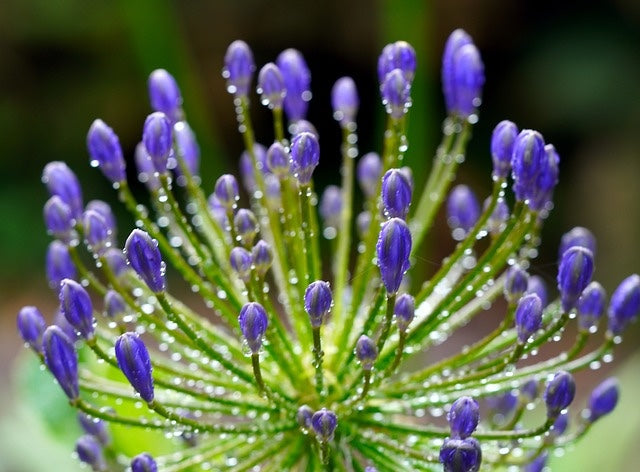
A Planting Guide to Agapanthus
Lesley Ann SandbachI love agapanthus and grow a wide variety in the garden. These are my guidelines for planting and caring for agapanthus to give you stunning blooms year after year from summer through to late autumn.
Image: Agapanthus plants bloom from summer to late autumn

What are agapanthus?
Agapanthus, also known as African Lilies, are South African perennials that are suitable for borders and large containers. They grow from rhizomes and have spreading, fleshy roots. In spring they produce mounds of strappy green leaves from which spring long stems carrying loosely spherical heads of trumpet-shaped flowers ranging from pure white, through silver grey to deep cobalt and regal purple. The smallest varieties are about 25cm tall and the tallest can go as high as 1.5m.
In my garden, they are indispensable plants for the late summer border.
Image: ‘Agapanthus africanus’ – a painting by the renowned botanical artist Pandora Sellars exhibited at the Shirley Sherwood Gallery, Kew Gardens

When should I plant agapanthus?
Now is the right time of year to be choosing agapanthus as late March is the time to plant bare-rooted rhizomes. Of course, potted plants are available throughout the summer and, although they are more expensive, you do have the advantage that they tend to be more sturdy plants.
How do I plant agapanthus and what conditions do they like?
The clue is in the country of origin. Almost anything that comes from South Africa likes full sun and well-drained soil; they will grow in shade but will not flower well.
Plant them in the border with the neck of the plant at the same depth as it was in the pot; if you are planting rhizomes, cover the noses with about 5cm of soil. Give them some space to grow so that they are not densely shaded by other plants and don’t forget that they will make large clumps over the years.
Image: Agapanthus will make large free-flowering clumps

If your soil is very damp, think about planting them in containers. Use a good-sized container where they can be left for years; they are happy in pots even if their roots are constricted but don’t let them become completely root-bound; lift and divide them every few years. They may not flower in the first year but, once established, they will be happy for years.
Image: Agapanthus will grow and flower happily in pots and tolerate being root-constricted

Image: Massed agapanthus in pots look stunning in a friend’s W Sussex garden
Which varieties should I plant?
The only thing to bear in mind is the hardiness of the plant. In my mother’s garden, agapanthus, like dahlias and penstemons, were not considered hardy and were lifted or cuttings taken in the autumn. In our milder winters, most of the deciduous varieties are considered fairly hardy.
Colour is the key to your choice and that depends entirely on your own garden. Among the smaller varieties, I grow Agapanthus ‘Exmoor’, a compact, deep blue which dances prettily at the front of the border. I tend to go for strong colours but fell in love some years ago with ‘Windsor Grey’ which I saw growing in huge clumps in a gravel garden at Pan Global Plants in Gloucestershire – it can grow to over 1m and the massed flowers are a silvery grey; they shimmer at dusk! There are an almost infinite number of blues to choose from but I grow ‘Black Jack’ a deep purple-flowered agapanthus that looks stunning with Geum ‘Totally Tangerine’.


Image: Agapanthus range from shades of silvery grey…to deep cobalt blue or imperial purple
How do I support my agapanthus?
Agapanthus don’t generally need to be supported but, if the leaves of the larger varieties are flopping, pop a one-ring herbaceous support over them as they emerge to keep them off the ground. Some of the taller flowers can be help upright with a metal stake; a large clump will benefit from 3 or 5 multi-ball stakes to hold the whole clump together
Image: A well-established clump of agapanthus may need a one-ring herbaceous support to prevent it from flopping
What conditions do agapanthus like?
Grow agapanthus in full sun and well-drained soil; they also grow well in containers and are happy to be constricted but not totally root-bound
How deep should I plant agapanthus?
Pot-grown agapanthus should be planted at the same depth as they are in the pot; rhizomes should be buried about 5cms below ground level
Can I grow agapanthus in pots?
Agapanthus are very happy in pots. Plant them in a large terracotta pot or half barrel and put them in the sunniest spot in the garden and they will reward you with flowers for years – perhaps not in the first year but they soon bulk up
Can I leave agapanthus in the ground overwinter?
Most agapanthus are now considered hardy. I always mark the clumps with a metal stake and mulch well in the autumn as they die down. If snow or a long spell of very cold weather is forecast, I do put bubble wrap around my precious, large terracotta pots
Which are the hardiest agapanthus?
The deciduous agapanthus (those whose leaves die back in the winter) are considered the hardiest although even the most hardy agapanthus will struggle in a very severe winter; evergreen agapanthus, normally considered tender, should be brought into the greenhouse in the winter


